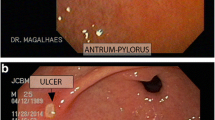Abstract
In our opinion the endogenous prostacyclin (PGI2) is one of the most important natural protective substances in the gastric mucosa. We have, therefore checked in experimental circumstances in rats, as well as in clinical observations in humans, the possible effect of smoking on endogenous gastroduodenal mucosal PGI2 level.
The animal experiments seem to verify that cigarette smoke really has an unwanted effect on the gastric mucosa. The target of this action is the endogenous PGI2 content of the mucosa.
According to our observations in humans there is a definite tendency toward decreased endogenous PGI2 production in the gastroduodenal mucosa of smokers too.
Similar content being viewed by others
References
J. R. Vane,Inhibition of prostaglandin synthetase as a mechanism of action for aspirin-like drugs. Nature (Lond)231, 232–235 (1961).
G. A. Higgs, E. A. Harvey, S. H. Ferreira and J. R. Vane,The effect of anti-inflammatory drugs on the production of prostaglandin in vivo. In:Advances in prostaglandin and thromboxane research. pp. 105–110 (Eds. B. Samuelsson and R. Poaletti). Raven-Press, New York 1976.
D. A. Brodie and B. J. Chase,Role of gastric acid in aspirin-induced gastric irritation in the rat. Gastroenterology53, 604–610 (1967).
R. Bugat, M. R. Thompson, D. Aures and M. I. Grossman,Gastric mucosal lesions produced by intravenous infusion of aspirin in rats. Gastroenterology71, 754–759 (1976).
A. Levy,Aspirin use in patients with major upper gastrointestinal bleeding and peptic-ulcer disease. N. Engl. J. Med.290, 1158–1162 (1974).
M. I. Grossman, K. K. Matsumoto and R. J. Lichter,Fecal blood loss produced by oral and intravenous administration of various salicylates. Gastroenterology40, 383–388 (1961).
T. A. Miller and E. D. Jacobson,Gastrointestinal cytoprotection by prostaglandins. Gut20, 75–87 (1979).
R. R. Martel, J. Klicius and F. Herr,Investigation of 1,3,4,9-tetrahydro-1-propylpyrano-[3,4-b]-indole-1-acetic acid [Prodolic acid]. A new nonsteroidal anti-inflammatory agent in rats. Agents and Actions4, 370–376 (1974).
C. A. Demerson, L. G. Humber, A. H. Philipp and R. R. Martel,Etodolic acid and related compounds. Chemistry and anti-inflammatory actions of some potent di-and tri-substituted 1,3,4,9-tetrahydropyrano[3,4-b]indole-1-acetic acids. J. Med. Chem.19, 391–395 (1976).
R. R. Martel and J. Klicius,Anti-inflammatory and analgesic properties of etodolic acid in rats. Can. J. Physiol. Pharmacol.54, 245–248 (1976).
R. R. Martel and J. Klicius,Comparison in rats of the anti-inflammatory and gastric irritant effects of etodolac with several clinically effective anti-inflammatory drugs. Agents and Actions12, 295–297 (1982).
J. Joubert, J. F. Mullane and M. Merlo et al.,Clinical pharmacological profile of Ultradol, a new nonsteroidal anti-inflammatory drug. Curr. Ther. Res.32, 74–88 (1982).
G. Vetter, M. Placchi and L. Jourbert,Comparative efficacy of etodolac and placebo in rheumatoid arthritic patients. Intl. J. Clin. Pharmacol. Ther. Toxicol.10, 240–245 (1982).
S. Ryder, J. Salmon, G. Jacob, M. Sanda, and J. Huth,Etodolac (Ultradol)—the safety profile of a new structurally novel nonsteroidal anti-inflammatory drug. Curr. Ther. Res.33, 948–965 (1983).
J. D. Arnold, J. Mullane and D. Hayden et al.,Etodolac, aspirin, and gastro-intestinal microbleeding. Clin. Pharmacol. Ther.35, 716–721 (1984).
I. Salom, G. Jacob, N. Jallad, C. A. Perdomo, J. F. Mullane and D. Weidler,Gastrointestinal microbleeding associated with the use of etodolac, ibuprofen, indomethacin, and naproxen in normal subjects. J. Clin. Pharmacol.24, 240–246 (1983).
M. Sanda, S. H. Collins, J. Mahady, J. Huth and K. Krantz,Three-month multicenter study of etodolac (Ultradol ®)in patients with osteorthritis of the hip. Curr. Ther. Res.33, 782–792 (1984).
G. B. Jacob, K. K. Hart, J. F. Mullane, S. Lutins and T. Y. Lee,Placebo-controlled study of etodolac and aspirin in the treatment of rheumatoid arthritis. Curr. Ther. Res.33, 703–713 (1983).
G. Jacob, M. Messina, E. Caperton, R. Gordon, G. Harris, B. Sack, P. Vreede and R. Weitzman,Safety and efficacy of etodolac, once or twice a day in the treatment of active rheumatoid arthritis. Curr. Ther. Res.37, 1124–1129 (1985).
E. S. Ferdinandi, M. N. Cayen and C. Pace-Asciak,Disposition of etodolac, other anti-inflammatory pyranoidole-1-acetic acids and furobufen in normal and adjuvant arthritic rats. J Pharmacol. Exp. Therap.220, 417–426 (1982).
D. Lee and D. Dvornik,Etodolac: effect on prostaglandin concentrations in gastric mucosa of rats. Life Sci36, 1157–1162 (1985).
M. N. Cayen, M. Kraml, E. S. Ferdinandi, E. Greselin and D. Dvornik,The metabolic disposition of etodolac in rats, dogs, and man. Drug Metab. Rev.12, 339–362 (1981).
R. R. Martel, J. Klicius and G. Metcalf,Effect of etodolac on articular and bone pathology associated with adjuvant arthritis in rats: a comparison with aspirin and naproxen. Agents and Actions14, 257–264 (1984).
R. Runkel, M. Chaplin, G. Boost, E. Segra and E. Forchielli,Absorption, distribution, metabolism, and excretion of naproxen in various laboratory animals and human subjects. J. Pharma. Sci.61, 703–708 (1972).
S. K. Baker and S. Niazi,Effect of water deprivation on aspirin disposition kinetics. J. Pharm. Sci.72, 1030–1034 (1983).
W. S. Powell,Rapid extraction of arachidonic acid metabolites from biological samples using octadecylsilyl silica. Methods in Enzymology86, 467–477 (1982).
F. A. Kuehl and R. W. Egan,Prostaglandins, arachidonic acid, and inflammation. Science210, 978–984 (1980).
D. Lee,Effect of etodolac (E) on the gastric mucosal prostaglandin levels in the rat. Fed. Proc.44, 1840 (1985).
M. Ligumsky, E. M. Golanska, D. G. Hansen and G. L. Kauffman Jr,Aspirin can inhibit gastric mucosal cyclooxygenase without causing lesions in rats. Gastroenterology84, 756–761 (1983).
S. J. Konturek, I. Piastucki and T. Brzozowski et al.,Role of prostaglandins in the formation of aspirin-induced gastric ulcers. Gastroenterology80, 4–9 (1981).
B. J. R. Whittle, N. K. Blughton-Smith, S. Moncada and J. R. Vane,Actions of prostacyclin (PGI 2)and its product, 6-oxo-PFG 1α on the rat gastric mucosa in vivo and in vitro. Prostaglandins15, 955–967 (1978).
M. Kraml, L. Cosyns and D. R. Hicks et al.,Bioavailability studies with etodolac in dogs and man. Biopharmaceutics Drug Disp.5, 63–74 (1985).
Author information
Authors and Affiliations
Rights and permissions
About this article
Cite this article
Balint, G.A., Varró, V. The effect of cigarette smoke on gastroduodenal mucosal endogenous prostacyclin level (Experimental and clinical observations). Agents and Actions 19, 224–232 (1986). https://doi.org/10.1007/BF01966210
Received:
Accepted:
Issue Date:
DOI: https://doi.org/10.1007/BF01966210




